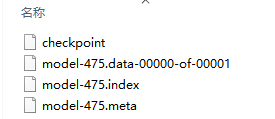【干货】TensorFlow中那些鲜为人知却又极其实用的知识
【导读】TensorFlow的生态圈极其强大,覆盖了科研、工程中的各种流程,其中一些特别好用的模块和技巧可以使你的工作效率大幅度提升,也可以让你的产品变得非常稳定。本文介绍其中的一些鲜为人知却又十分实用的知识。
一. GraphDef才是正确地模型保存的方法
大部分用户保存TensorFlow模型的方法是tf.train.Saver.save,这是众多科研代码中用来保存模型的方法,保存之后的模型如下图所示。
实际上这种保存的方法,是给模型训练做checkpoint用的,也就是说为了让你能够随时保存实验过程,随时恢复实验用的(防止断电、死机导致实验丢失)。
如果你希望为TensorFlow保存一个能够用于产品用的模型,并且这个模型能够被C/C++/Java/NodeJS等调用(类似Caffe模型),你需要了解GraphDef。用GraphDef方式保存的模型是一个独立地Protobuf文件,看一下维基百科对Protobuf的解释:
Protocol Buffers是一种序列化数据结构的协议。对于透过管线(pipeline)或存储数据进行通信的程序开发上是很有用的。这个方法包含一个接口描述语言,描述一些数据结构,并提供程序工具根据这些描述产生代码,用于将这些数据结构产生或解析数据流。
也就是说Protobuf文件是一种无视语种的数据描述文件,存成Protobuf文件,模型可以被Protobuf支持的各大语种(C/C++/Java/NodeJS等)读取。
TensorFlow模型的正确保存方式如下:
#coding=utf-8
import tensorflow as tf
# 定义图
x = tf.placeholder(tf.float32, name="x")
y = tf.get_variable("y", initializer=10.0)
z = tf.log(x + y, name="z")
with tf.Session() as sess:
sess.run(tf.global_variables_initializer())
# 进行一些训练代码,此处省略
# xxxxxxxxxxxx
# 显示图中的节点
frozen_graph_def = tf.graph_util.
convert_variables_to_constants(
sess,
sess.graph_def,
output_node_names=["z"])
print(frozen_graph_def)
# 保存图为pb文件
with open('model.pb', 'wb') as f:
f.write(frozen_graph_def.SerializeToString())
最终,我们只会得到一个model.pb文件:
model.pb存储的是压缩版的frozen_graph_def,上面我们用print函数将frozen_graph_def 输出的结果如下,这可以看到,这是一个标准的图结构的数据(也就是静态图),不仅包含了节点,还包含了节点中的数据。
node {
name: "x"
op: "Placeholder"
attr {
key: "dtype"
value {
type: DT_FLOAT
}
}
attr {
key: "shape"
value {
shape {
unknown_rank: true
}
}
}
}
node {
name: "y"
op: "Const"
attr {
key: "dtype"
value {
type: DT_FLOAT
}
}
attr {
key: "value"
value {
tensor {
dtype: DT_FLOAT
tensor_shape {
}
float_val: 10.0
}
}
}
}
node {
name: "y/read"
op: "Identity"
input: "y"
attr {
key: "T"
value {
type: DT_FLOAT
}
}
attr {
key: "_class"
value {
list {
s: "loc:@y"
}
}
}
}
node {
name: "add"
op: "Add"
input: "x"
input: "y/read"
attr {
key: "T"
value {
type: DT_FLOAT
}
}
}
node {
name: "z"
op: "Log"
input: "add"
attr {
key: "T"
value {
type: DT_FLOAT
}
}
}
library {
}
为什么在保存GraphDef前要调用tf.graph_util.convert_variables_to_constants方法,我们发现在调用tf.graph_util.convert_variables_to_constants方法时,程序有一行输出:
Converted 1 variables to const ops.
其实默认状态下,静态图的数据是被同时保存在GraphDef和Session中的,图结构、常量的值等被存储在GraphDef中,而变量的值被存储在Session中,这也是为什么每次用静态图都要在Session中使用的原因。
tf.graph_util.convert_variables_to_constants方法将Session中的变量转换到GraphDef中以常量形式存储,由于没有了变量,得到的GraphDef中包含了静态图的所有信息,即包含了整个模型,保存GraphDef即保存了整个模型。
现在我们可以用C/C++/Java/NodeJS等来读取并执行保存的GraphDef文件,以Java为例(需要Maven导入java版tensorflow api),整个流程和Python API很像,读取图,开启Session,并将读取的图放入Session,指定输入,获取输出:
import org.apache.commons.io.IOUtils;
import org.tensorflow.Graph;
import org.tensorflow.Session;
import org.tensorflow.Tensor;
import java.io.FileInputStream;
import java.io.IOException;
public class DemoImportGraph {
public static void main(String[] args) throws IOException {
try (Graph graph = new Graph()) {
//导入图
byte[] graphBytes = IOUtils.toByteArray(new FileInputStream("model.pb"));
graph.importGraphDef(graphBytes);
//根据图建立Session
try(Session session = new Session(graph)){
//相当于TensorFlow Python中的sess.run(z, feed_dict = {'x': 10.0})
float z = session.runner()
.feed("x", Tensor.create(10.0f))
.fetch("z").run().get(0).floatValue();
System.out.println(z);
}
}
}
}
所以,TensorFlow模型并非只能被Python调用。按照GraphDef方式保存为Protobuf模型后,可以被任何TensorFlow提供了API的语种调用。
详情可以参考:
http://www.zhuanzhi.ai/document/5f2d760783fb7a0d49e971140a1c4561
二. 可以在Keras中使用TensorFlow,也可以在TensorFlow中使用Keras
TensorFlow是最终要的内核之一,在默认的使用TensorFlow作为内核的情况下,Keras的各种层、包括模型的执行,都是依赖TensorFlow的各种操作、Session等去完成的,在Keras中使用TensorFlow是众所周知的,然而在TensorFlow中使用Keras确是一个不常见的情况。其实Keras早就进入了TensorFlow的核心库(tf.keras),而且成为了官方较为推荐使用tf.keras进行模型的构建,看一下TensorFlow 1.9官网教程首页的示例代码,
import tensorflow as tf
mnist = tf.keras.datasets.mnist
(x_train, y_train),(x_test, y_test) = mnist.load_data()
x_train, x_test = x_train / 255.0, x_test / 255.0
model = tf.keras.models.Sequential([
tf.keras.layers.Flatten(),
tf.keras.layers.Dense(512, activation=tf.nn.relu),
tf.keras.layers.Dropout(0.2),
tf.keras.layers.Dense(10, activation=tf.nn.softmax)
])
model.compile(optimizer='adam',
loss='sparse_categorical_crossentropy',
metrics=['accuracy'])
model.fit(x_train, y_train, epochs=5)
model.evaluate(x_test, y_test)
原先在TensorFlow需要几十行才能构建的模型和流程,用tf.keras模块十几行就可以搞定了。
三. TensorFlow Hub中有许多可以直接使用的模型
TensorFlow Hub是TensorFlow官方提供的用于模型发布、复用的工具。例如下面的代码可以获取句子的Embedding,我们只需要给出TensorFlow Hub模型发布的url以及输入,通过简单的几行调用即可完成原先需要数百还才能完成的工作。另外,指定url的方式相比于自己下载模型的方式便利了许多。
import tensorflow as tf
import tensorflow_hub as hub
with tf.Graph().as_default():
module_url = "https://tfhub.dev/google/nnlm-en-dim128-with-normalization/1"
embed = hub.Module(module_url)
embeddings = embed(["A long sentence.", "single-word",
"http://example.com"])
with tf.Session() as sess:
sess.run(tf.global_variables_initializer())
sess.run(tf.tables_initializer())
print(sess.run(embeddings))
参考链接:
https://www.tensorflow.org/hub/
四. 在静态图中也可以像动态图那样写条件判断语句
原先在静态图中是无法使用Python的if语句来为静态图定义条件判断结构的,需要使用特殊的tf.cond操作来定义一个条件判断节点,非常的麻烦,近期TensorFlow新出的AutoGraph功能可以让用户按照Python的if语句来定义结构,然后利用AutoGraph注解将其转换为相应的静态图结构,这样可以大幅度降低静态图构建的难度:
@autograph.convert()
def fizzbuzz(num):
if num % 3 == 0 and num % 5 == 0:
print('FizzBuzz')
elif num % 3 == 0:
print('Fizz')
elif num % 5 == 0:
print('Buzz')
else:
print(num)
return num
with tf.Graph().as_default():
# The result works like a regular op: takes tensors in, returns tensors.
# You can inspect the graph using tf.get_default_graph().as_graph_def()
num = tf.placeholder(tf.int32)
result = fizzbuzz(num)
with tf.Session() as sess:
for n in range(10,16):
sess.run(result, feed_dict={num:n})
参考链接:
https://www.tensorflow.org/guide/autograph
-END-
专 · 知
人工智能领域26个主题知识资料全集获取与加入专知人工智能服务群: 欢迎微信扫一扫加入专知人工智能知识星球群,获取专业知识教程视频资料和与专家交流咨询!
请PC登录www.zhuanzhi.ai或者点击阅读原文,注册登录专知,获取更多AI知识资料!
请加专知小助手微信(扫一扫如下二维码添加),加入专知主题群(请备注主题类型:AI、NLP、CV、 KG等)交流~
请关注专知公众号,获取人工智能的专业知识!
点击“阅读原文”,使用专知








